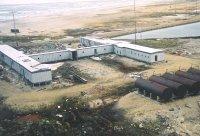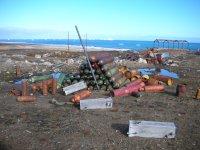Cape Christian Remediation Project
Brief overview

This site is located on the east coast of Baffin Island at the mouth of the Clyde River, facing the Davis Strait. The nearest community, Clyde River, is located approximately 14 kilometres to the southeast of the site and linked via an all-terrain vehicle trail.
The United States Coast Guard (USCG) established a long-range navigation site at Cape Christian in 1954, which included a main station, a residential building, an airstrip and terminal, fuel storage facilities, an antenna, and storage and emergency buildings. The USCG abandoned the site in 1975, and it was returned to the Canadian government with all the existing facilities and materials in place.
Why is this a contaminated site?

During the period the site was occupied by the USCG, several areas around the site were used as dumps for solid wastes and barrels. There are several waste barrels at the site and some of the buildings contain asbestos, polychlorinated biphenyls (PCBs) amended and lead paint. The soil at the site is contaminated with hydrocarbons, zinc, lead, cadmium, copper, and chromium.
What's going on at the site?
Between 2002 and 2004 water sampling occurred at the site to ensure no off-site migration of contaminants. In 2006, INAC completed a comprehensive environmental site assessment to determine the full extent of the contamination. In 2007, Qikiqtaaluk Logistics was awarded the Cape Christian remediation contract committing to over 85 per cent Inuit employment and to providing 75 per cent of sub-contract work to Inuit firms. Work will begin in 2008.
Future plans
It is anticipated site remediation will be completed by 2010 followed by a 25-year monitoring program.